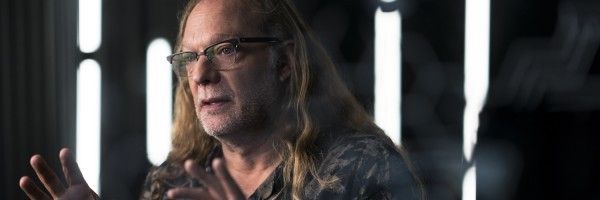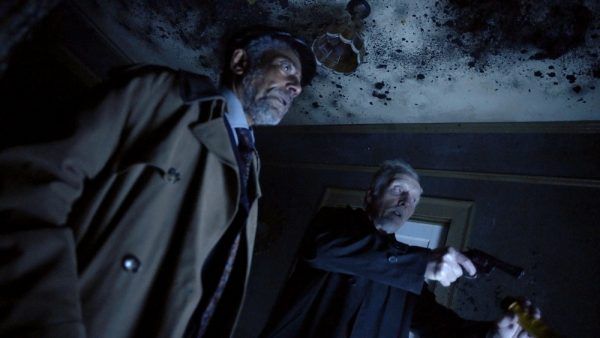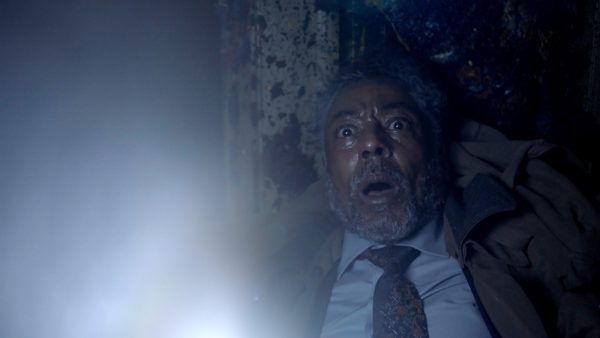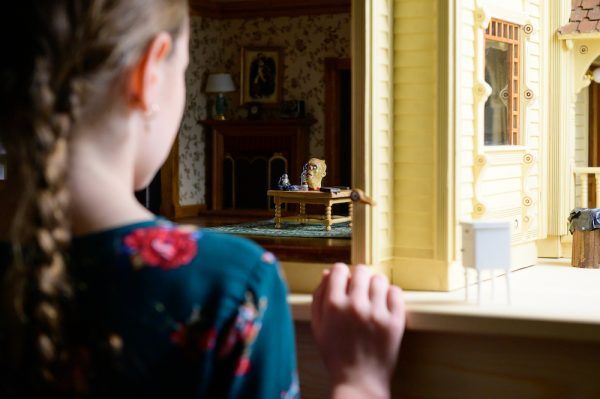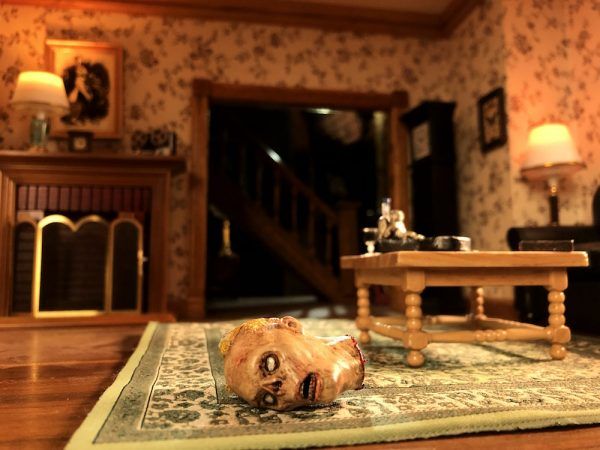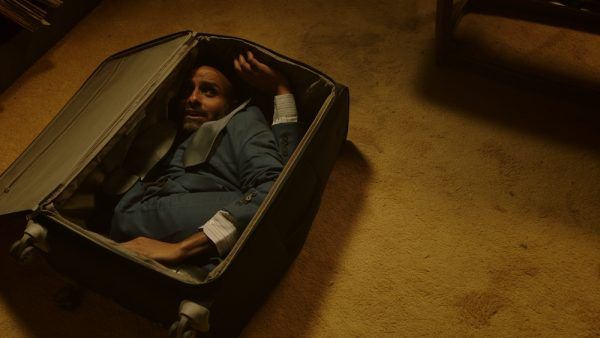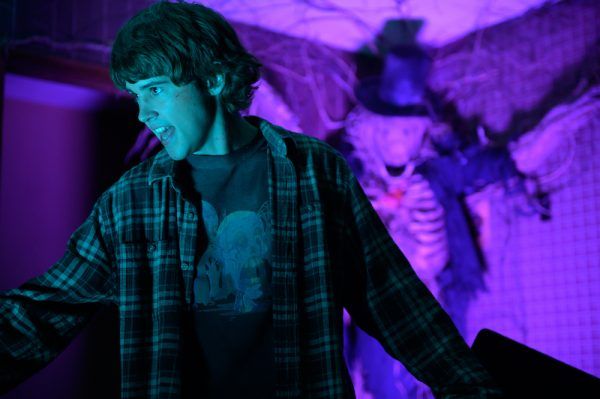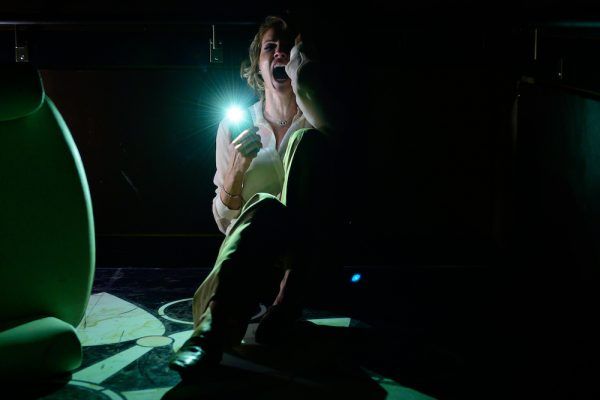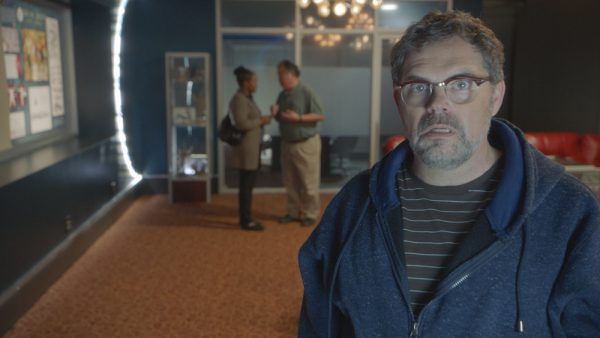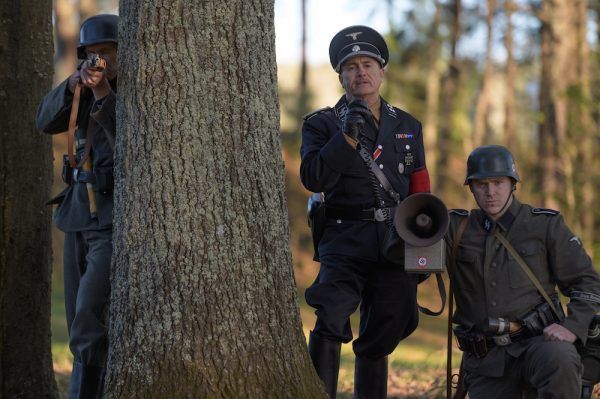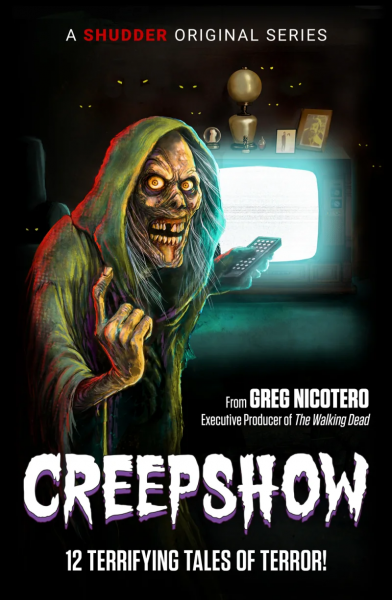It's 4 in the morning as we make our way through a living room lit only by the streams of our flashlights. Every surface of the room is covered in a creeping mold, even the dozens of discarded beer cans that litter the floor and an eccentric ashtray on the coffee table. Moving into the kitchen, we restrict the sweep of our flashlights; there are some things we just don't want to see. The floor, the kitchen counter, every surface is covered in the rotting remains of small animals, each more horrific than the last. Turning down the hall, more horrors await us still, but we never see them. A massive, amorphous shape rises up out of the darkness ahead of us and we turn our lights upon it just in time to see it attack. And that's when Greg Nicotero calls, "Cut!"
Though we didn't get a chance to chat directly with Creepshow showrunner Nicotero, who was busy handling director duties for the Shudder series' opening segment "Gray Matter" while prepping and approving another segment that was in production, our group of visiting journalists did get a chance to speak with him during post-production. We were able to get his thoughts on "Gray Matter" and working with Giancarlo Esposito and Tobin Bell for the scene in question, an adaptation of the Stephen King short story. More broadly, Nicotero talked about getting his first crack at showrunner duties with Creepshow, staying true to the franchise while varying the tone with each segment, and how important collaboration has been throughout his career, including his ongoing work on The Walking Dead.
Creepshow debuts on Shudder today, so some spoilers follow in our chat with Nicotero below:
Creepshow is your first time working as a showrunner. What's that been like?
Greg Nicotero: Well, you know, I think I had a pretty good proving ground working so intimately with Frank Darabont and Scott Gimple and Angela [Kang] on The Walking Dead. But everything's a different animal. I think the trick with Creepshow for me was I really felt a tremendous obligation to not only be respectful to the original material but also to develop new stories with up-and-coming writers and directors.
So it was intense. We were super ambitious and the fact that we wanted to do two stories in each episode as opposed to just one story per episode meant that every three-and-a-half days we were creating a new universe with new sets, and new cast, and new material. So I don't really think I had thought it all the way through when I stepped into this. But, you know truth be told, it's been an amazing experience. I've been doing this a long time, man. I've been in the business since 1988. So, I love the idea that I'm still learning and I'm still evolving as a filmmaker.
What's it been like finishing this while working on Walking Dead and overseeing all the other special effects projects you have?
Nicotero: It's definitely a challenge. We shot Creepshow during The Walking Dead hiatus. So, when I was wrapping up season nine we were already in development on a lot of the stories for Creepshow. I think I finished editing the finale of Walking Dead like December 14th or 15th and then had a little vacation with my family at Christmas. Then in January we were right into it. We prepped for a month in Atlanta and we shot February and March. And so, there really was no stopping, and there was no taking a breath or anything like that because once you're in production and you really, really start, you know, you got to feed the animal. It's pretty insane.
With all the anthology series that are coming out, like Amazing Stories and Twilight Zone, how do you see Creepshow standing out from the rest?
Greg Nicotero: Well, I think the big thing honestly is that Creepshow has a very unique tone and style to it. Whereas Twilight Zone you're always waiting for the twist ending. And, the thing I liked about the original Creepshow was the stories were all a little bit different. Some of them were scary. Some of them were suspenseful. Some of them were gross. Some of them were funny. So, I really do feel like that's what we're intending to continue, which is it's like going to a great restaurant and you have no idea what you want to order, but you're going to be happy with whatever shows up in front of you.
I think it's exciting that we get an opportunity to explore a bunch of different themes and a bunch of different stories. And you know, even just the vibe of the show in general, I mean, listen, I mean, I was born in '63 and I'm kind of a kid of '70s, and early '80s horror movies and American Werewolf in London and The Thing, and Dawn of the Dead, and all those movies. So, for me there's a really specific style with which those movies were made that people have tried to emulate. And that's one of the things that I really wanted to do with Creepshow.
It doesn't necessarily need to feel like a period piece, but there's a specific style, and that's something that I was really excited about, you know what I mean? We're doing the comic book page turns in the dissolves from the comic book to live action. I think some of the most fun that I've had has been designing the retro ads that we're putting in the comic book and all the covers. So, I really feel like I did a deep dive not only into obviously the original Creepshow but what inspired Stephen [King] and George [Romero], because Creepshow's really an homage to EC Comics. So, to go into this and do Creepshow again, you got to go back to the source and you got to go back to what it was that inspired these guys. And that, you know, that the EC Comics were all kind of outrageous and a little crazy and a little funny. So, that was kind of fun.
Can you talk about your interest in, not just the comic source, but the influence of King?
Nicotero: Well, I've always been a massive fan of his books. I mean, I've read everything that he's written. I think when Pet Semetery came out, I read the entire book in a day. Like I just couldn't put it down. I love The Stand. I love Salem's Lot. I'm just a big fan of his work. And so, when I found myself in the movie industry it just seemed sort of ironic that after reading Pet Semetery and reading The Mist and reading the stories that he had written, and I found myself standing on set next to him working side by side with him.
I think it's one of the reasons why Walking Dead came out of the gate so strong was, you know, Frank Darabont and Stephen King were great partners and they were great partners for a very big reason. One of those reasons was that Frank loves ensemble character pieces with strong characterizations and Steve has spent his career creating relatable characters. Like, any of his books that you read, there's somebody in there that you can relate to. And, I think that that's what ultimately made The Walking Dead the mammoth success that it started out to be was because of those characters were all relatable.
Any Steve King story that you read, even if the characters are despicable, there's something about them that you love. There's something about them that you can identify with or relate to. So, I always loved his books. I was always terrified by them and couldn't put them down. I remember reading Tommyknockers and it was like a thousand pages and I was like, "I'm getting it," I just couldn't get enough. So, as soon as this happened, he was really the first call because I didn't feel like you could do Creepshow without a King story. So, to be able to continue the tradition and continue with Joe Hill sort of brings it full circle to me, so.
I'm just curious to know how does this journey feel so far? How has it been for you?
Nicotero: It was definitely the intent to capture the charm of the original Creepshow. That was something that I really wanted to do and we really set out to do right out of the gate. Knowing that we have stories that have a scarecrow, and werewolves, and creatures, and monsters, I wanted that stuff to be practical. I mean, I wanted it to feel real. You know, one of the greatest compliments that I got from Giancarlo [Esposito] and Tobin [Bell] when we shot "Gray Matter" was, they said, "Listen, nowadays people walk onto a green stage and they react to a green ball and then everyone goes, 'Oh yeah, don't worry, we're going to put the backgrounds in later. We're going to do all that later.'" The fact that Giancarlo said, when he walked on set for "Gray Matter" into Richie's apartment and he said, "It didn't take much for me to get there where I needed to be emotionally because I felt like I had walked into this just the weirdest place I had ever been in terms of, you know, the mold overtaking the apartment and all that kind of stuff."
So, it's so important and I think very often a lot of people tend to forget that it's such an immersive experience. For me, I wanted the creature stuff to be practical. And it's funny because in this video game age that we live in, a lot of people don't really know how to look at practical stuff without immediately thinking, "Well, it doesn't look like a video game. So, it looks strange." I've experienced people who don't understand that when you see a practical effect, that's the way it's intended to be lit, the way it's intended to be shot, the way it's intended to be framed. So, I really had a good time doing all that stuff. But you know, the guys in the shop, they were so over the moon that we got to actually build a bunch of creature stuff. That was really kind of exciting.
I was wondering if you might be able to talk a little bit about your approach to directing "Gray Matter" and what sort of tone you are trying to set with it.
Nicotero: Well, you know what's funny about that is it's a really complex story because on the surface it's like, "Oh, well there's this guy and he drinks beer and then he starts metamorphosing into this creature." You know? But what I found interesting when I read it is it's really much more a story about alcoholism and co-dependence and the fact that the story is being told through the eyes of Timmy, his little boy. And he's like, "I don't understand it. He's changing and there's nothing I can do about it."
But you know, the unique aspect of the story is it really is about the relationship between the son and his father. And his father not knowing any other way to deal with his grief other than through alcohol. And the little boy really doesn't know what else to do. So, he ends up enabling his dad. When you sort of boil the story down into that, I really wanted there to be this connection between them, between the characters, that propels the story. So, you're kind of jumping back and forth between watching Timmy and his dad, their relationship dissolve. Then in the present day you realize that Timmy is kind of sending Chief and Doc into this sort of wasps' nest and we don't know what's going to happen.
So, a lot of it is this kind of really heartfelt story between a father and son who are desperately trying to survive and not doing a very good job. And then you have this other very suspenseful, like what's behind that door? What's going to happen as Chief and Doc head towards the apartment? To me, it's all about relating to the characters. You know, if I learned anything in my 35 years of makeup effects is if you don't care about the characters, then the coolest monster, the coolest set piece, the coolest visual effect, none of it matters if you don't care about these people.
I really wanted to make sure that the performances were there and that the characters were relatable. So, on top of all that, then you've got the monster movie aspect of it. So, it really was something very different for me to do. And in that way I really enjoyed that. And I feel like, you know, of course any filmmaker will tell you that they would go back and they were like, "Oh, well I would try this different. I would do this different." But that's the exciting part about creating is that you have this opportunity to tell this story, but the stories always evolve and always change. But I really feel like we captured the intent of Stephen's story and he hasn't seen him yet. So, I'm kind of dying to hear what he thinks.
Can we expect a Season Two?
Greg Nicotero: You know, there's been discussions about it. But we're really just flying towards the finish line. The nice thing about this is we got lots of material we developed. For season one, my original massively insane idea was that I wanted to do three stories per episode, not two. So, I was like, "Guys, we need 18 pieces of material," and I really want it to mirror it off of like Night Gallery where one episode could be 18 minutes and one episode can be seven minutes and one episode could be, you know, 24 minutes. I love the short form medium where you don't have to worry about act one, act two, act three. You just tell the story and use the exact amount of time that you need to tell this tale.
So, we developed a lot of material and there was a lot of stuff that I was like, "Oh my God, I love this, but I don't know if we're going to be able to do it for season one." So, we have some stuff in our pocket already for sure. But you know, at this point, every single day I'm reviewing music and visual effects and then running to set for Walking Dead and then directing there and then I go home. And then I look at more visual effects. And, so I'm kind in, you know, it's like, remember the house in The Wizard of Oz that gets pulled into the tornado? That's kind of how I feeling right now, in a good way.
We were there for the "Gray Matter" night with Tobin and Giancarlo. So, looking back, what do you remember about that night working with those actors?
Nicotero: When they walked on the set their jaws dropped. I think the challenge, the big challenge with that particular night for me was on Creepshow we shot 10 pages of material a day. We had to move really fast. Now, I'm accustomed to that because on Walking Dead we have lots of material to cover, as well. So, I was like kind of block shooting everything with the actors and you know, you bring him down here. And I remember at one point we were getting to a very specific reveal and Tobin was like, "I want to make sure we get this moment." I said, "Trust me, I know exactly where it's going to play and I know how it's going to work." Then when we turned around and shot his reaction to something that he had just seen, he pulled me aside. He's like, "Okay, I got it now. I got it, I got it."
It was really great with those guys because the set was so beautiful and the mood was so unsettling that at any moment I think they were afraid something was going to jump out from some corner. Which is good because that's what we wanted. And you know, we shot a lot of material in a very short amount of time and I was really happy. I really proud of it and I think that the sequence is terrifying and suspenseful and mysterious. I loved that you guys were there because it was sort of, I felt like I had an audience so I could like take you guys in and "Okay, now we're going to do this here." You know, I mean, I was really excited about it because you guys and the actors, you sort of came into it with fresh eyes and you know, I hope it won't be lost on anybody that there's a little bit of Jordy Verrill vibe in there when you get into that apartment with all the moss and the mold growing everywhere, and I kind of dug that too.
At this point in your production process, what are you most proud of with Creepshow?
Nicotero: I'm most proud of what we accomplished. When the network watched the first cuts, we did this for very little money and very quickly. But you know, I was really, really proud of the fact that when studio people looked at it, they were like, "Wait, how long did you take to shoot this? How did you guys do this?" I think it was a lot of just everybody, you know, my production designer Aimee [Holmberg], and Rob Draper, my DP, and make-up effects, and props, and set dec, and visual effects, every single person was on board for the same reason I was on board. They're like, "This is Creepshow. We're doing Creepshow. How amazing is this? This is a great opportunity for us."
It was definitely, and I know I've sort of been endlessly quoted in saying that it's the hardest thing I've ever done, but you know, knowing that I've been able to grow as a filmmaker and collaborate with some great actors and some great writers and some great directors, that makes me really, really proud, for sure.
What is it that you can't wait for audiences to see?
Nicotero: What I'm excited about is that every episode has a different vibe and a different flavor to it. And, I think what's exciting for me about that is each week people are going to watch episodes and have a different experience. And that I think is something that sets us apart from different anthologies. And I'm really, really, excited about that. So, that part of it, I think I'm most excited about is just getting a chance to see, getting a chance to have these different experiences as they watch an episode.
Could you talk a little bit about how you see the advantage of being on a genre-oriented service like Shudder is going to be for the series?
Nicotero: What I love about Shudder is, it's dedicated strictly to horror and genre stuff. Like if I go on iTunes or I go on another streaming service, if there's not something specific that I want to watch, I find myself searching and I always end up in the horror category. I always end up in sci-fi or horror to look to see what's new.
What's great about Shudder is I feel like the stuff that I would want to watch, it's kind of right there. I don't feel like I need to dig through multiple genres and like new releases and all this kind of stuff. I feel like it's what, you know, for those of us that love horror, it's kind of right there. And, Sam Zimmerman who is the curator, [and] the folks at Shudder, like they're at film festivals and they're watching all this new stuff, and a lot of it is European and Asian, the horror fare.
I really enjoy the fact that these guys really are scouring the globe for the best in the genre and making it available for people to see. It's not just playing back catalogs of stuff that they bought from some company or something. But they're really looking, actively looking, to sort of expand the viewer's horizons and opening them up to different types of material from all over the world. I love that. Creepshow's their first original show, so, I'm really excited about that and kind of raising awareness of those of us that are horror fans to like, "Hey, there's a network out there that you can get that really caters to people like us that love horror."
Everyone we spoke with talked about how collaborative you are. Do you have a sort of philosophy about collaboration or being open to ideas wherever they come from?
Nicotero: Well, you know what's interesting for me is I feel like that really is the spirit of how I got into the business. You know, as a makeup effects artist, you're the first person in the trailer in the morning. You transformed this actor into this character. Then they go to set and then at the end of the day you clean them up. So, you develop a really unique relationship with your actors. They have to trust you. They have to trust that you're going to transform them into this character and you're going to do it successfully. So, you have that aspect of it. And then when you're dealing with directors and you have guys like Sam Raimi, and Robert Rodriguez, and Quentin Tarantino, it's really all about you realizing their vision and collaborating with them.
I always say that when any movie you have, the first meeting is the most exciting because everything comes out, everything's on the table. Like you're not worried about schedule, you're not worried about budget, you're just brainstorming ideas. And for me, one of the most exciting times of any project is when you sit with the director and you start brainstorming ideas. And, you know, like my relationship with George Romero and even with Quentin, on Once Upon a Time In Hollywood, you know, Quentin a lot of times will be like, "Well, listen dude, you know, I don't know how to tell you what to build. I just know what I need to accomplish the specific shots." So, for my career with Quentin, our working relationship has been solely based around, we talk about something, I go off and build it and then I shoot tests and footage and then I bring it to him and nine times out of ten he films it almost exactly the way that I had proposed it to him because he knows that we've talked about the intent of what the sequence involves.
I feel like so much of what I do is collaborating with directors and writers and actors to get the best work out of them. So, on Creepshow, it was really important to me to continue that collaboration, and even more so because we didn't have six months to shoot the show, we had two months to shoot six episodes. So, I needed to make sure that everybody was on the same page. I needed them to know what gags were important to me, what emotional beats were important to me, what shots were important to me, and in most of the cases we were successful in that.
Any art form, and especially with my actors, I do want to say like on Walking Dead, working with Andy [Lincoln], and Norman [Reedus], and Jon Bernthal, and Lauren Cohan, and Jeffrey Dean Morgan, like I've learned that when the actors come to set, they're invested in their characters. They put work and thought into it. So, if they show up, they have thoughts and ideas about how to make their character better because their character was created by them and it's part of them. So, I love anytime I'm directing an episode of The Walking Dead or even on Creepshow, I love sitting with the actors and spending time just talking about my perceptions of their characters, their perceptions of their characters because then the actors feel free when they show up on set to work. My goal is to create an environment for everybody to feel safe, as a director and as a creator. And that's what we did on Creepshow.

